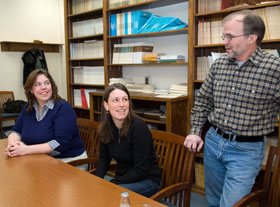  |
| HOME | THIS ISSUE | CALENDAR | GRANTS | BACK ISSUES | < BACK | NEXT > |
Speaker: ancient skeleton led to new view of human settlement in Americaby Cindy Weiss - February 6, 2006 |
||||
|
James C. Chatters, a forensic archaeologist and paleoecologist whose life and career changed 10 years ago when the 9,400-year-old “Kennewick Man” was discovered, warned anthropology students here last week that “you never know where your career will take you.” Chatters was 45 when he was called in to investigate the discovery of a human skeleton on a bank of the Columbia River in Kennewick, Wash. He was the first to study the bones, which were later radiocarbon dated. The skeleton is one of the oldest found in North America, and Chatters said it has caused him to change his views about how America was settled. Scientific examination of it was interrupted, however, when the Army Corps of Engineers seized it on behalf of Native American tribes, who wanted to rebury the remains as an ancestor. Nearly a decade of legal battles ensued, with eight anthropologists (Chatters was not among them) challenging the impoundment. Last summer, after an appeals court ruled that the remains were not related to the Native Americans, scientists were again allowed to examine Kennewick Man. Chatters, who has written a book about the finding, Ancient Encounters: Kennewick Man and the First Americans, came to Connecticut recently to give a talk sponsored by the Friends of the Office of State Archaeology and the Connecticut State Museum of Natural History and Connecticut Archaeology Center at UConn. Accompanied by state archaeologist Nick Bellantoni, he met with anthropology department students and faculty for lunch. He told them that the aftermath of the Kennewick Man discovery has been “a hard thing,” with the press portraying him as a racist and an Indian tribe with which he once had a good relationship blacklisting him. One of the first findings about the skeleton was that it had Caucasian features. Chatters again conducted a study on the remains in July — a CAT scan of the skull and pelvis – and has plans to scan as many of the bones as possible.
“For me, it was a chance to finish what I got started on,” he said. His research has also revised his opinion about how America was settled by humans. Previously, he accepted the traditional view that Paleo-Indians, 14,000 to 9,000 years ago, calrrying Clovis-style spear points, represented one founding wave of human development that came to North America from Asia using a land bridge, beringia, over the Bering Strait. Now he believes there may have been multiple waves of migration, perhaps in coast-hugging boats as well as by the land bridge, and that humans may have come to America from more places in Eurasia than previously thought. Skull patterns in early America are most similar to those from Korea, he said, and a lot of early artifacts and tools found in North America correspond to similar types found as far away as Poland. “It’s opened my mind to the possibilities,” Chatters said. “The picture is considerably more complex.” “If you look at the history of humanity, it’s a history of constant moving,” he said, and early people were “capable of a tremendous amount of technological advancement.” |
| ADVANCE HOME UCONN HOME |

